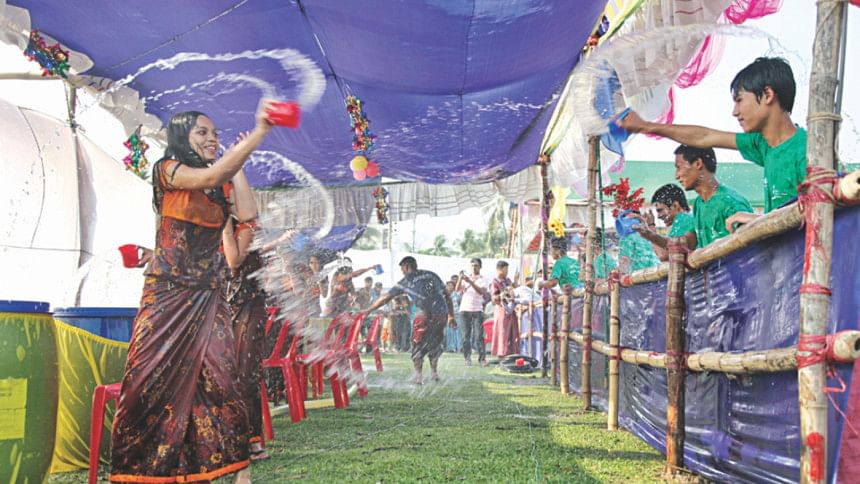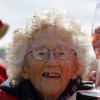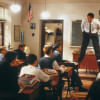Festive look in Bangladesh hills

The majestic and mysterious hills might look serene from a distant. However, as one travels along the winding roads in the three hill districts, the exuberance ahead of the New Year among the ethnic communities there cannot go unnoticed.
As the sun burns bright on the picturesque hilly landscape, almost all of the ethnic minorities of the country celebrate the turn of the year at this time of the season with hopes for a better, more prosperous year ahead.
The five-day celebrations have different names for different communities -- Bizu for the Chakmas, Sangrai for the Marmas, Boishu for the Tripuras, Bishu for the Tanchangyas, Sankran for the Mros, and Sankrai for the Khumis.
Together, they are called the Boishabi festival which has already began in the remote Mro villages in Bandarban.
One such village is Sakhoy Para, located in Tonkaboti union 14km uphill from Bandarban Sadar. Decked out with intricate floral decorations, the small village looked like a small kingdom popped out from some fairytale.
As the sweet smell of indigenous delicacies wafted around, Mro men and women from the surrounding hills gathered in the village and were revelling in different indigenous sports.
The Mro male musicians were playing long bamboo horns while the women, wearing traditional dresses and ornaments, were dancing along.
A village fair for young men and women will be held at the remote Ruifu Mro Para, 40km from Bandarban Sadar, tomorrow.
"This is an opportunity for the young people of our community to meet each other," said Singyoung Mro, member of Bandarban Hill District Council.
"An interesting feature of this fair is that boys and men on this day have to buy whatever a women or girl asks for, even if she is a stranger."
For the Chakmas, the three-day celebration starts with Fulbiju or the flower-floating programme today.
People get up early, clean their houses and decorate them with flowers, and float flowers in rivers, canals and springs to seek blessings of God for peace and prosperity. In the evening, they go to Kyangs (Buddhist temples) and light candles.
The second day is called Mulbiju and an indigenous specialty called Pachon is cooked and enjoyed by the community members. The last day, known as Goijja Pojjya Din, is spent by taking rest.
While different sorts of competitions of indigenous games are held at the Rangamati Town Stadium, Raicha Shatkamol Para in Bandarban is a village where the Thanchangya community arrange Ghila Khela programme every year.
The Marma community in Bandarban will start Sangrai with a colourful procession called Mongol Shobhajatra today. Tomorrow, Buddhist devotees will deliver Chhoaing (special preparation of food) to venerable monks.
In the afternoon, they would bring out a procession and bathe a statue of Lord Buddha in the Sangu or the Shankho river, kicking off the traditional water fight.
People throw water at each other to symbolically cleanse everything that was old and weary.
On April 15 and 16, a cultural programme featuring Maitree Pani Barshan, in which people will shower each other in a gesture of friendship, will be held at Puraton Razar Math at 4:00pm in the Bandarban Sadar town.
The Chakma, Marma and Tripura communities also organise Elderly Pouja in which they show respect to the community elders by giving them showers and new clothes.
The Tripuras will start Boishu celebration tomorrow with Harboishu, the first day of New Year, through programmes to show respect to nature and the birds, animals and insects of the universe to please their mythical god Goraiya.
Tripura young girls scatter rice on their yard to feed birds and domestic animals. Their houses are decorated with flowers to welcome guests. They also go to rivers to float flowers.
The Boishabi festival coincides with the Bengali New Year, connecting the people of different ethnical and cultural backgrounds in their joys and celebrations.

 For all latest news, follow The Daily Star's Google News channel.
For all latest news, follow The Daily Star's Google News channel. 








Comments